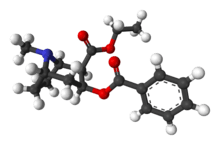Cocaethylene
 | |
 | |
| Clinical data | |
|---|---|
| Pregnancy category |
|
| Dependence liability | Moderate to High |
| Routes of administration | Produced from ingestion of cocaine and ethanol |
| ATC code | none |
| Legal status | |
| Legal status |
|
| Identifiers | |
| |
| Synonyms | benzoylecgonine ethyl ester, ethylbenzoylecgonine, |
| CAS Number | 529-38-4 |
| PubChem (CID) | 65034 |
| ChemSpider | 559082 |
| ChEMBL | CHEMBL608806 |
| Chemical and physical data | |
| Formula | C18H23NO4 |
| Molar mass | 317.38 g/mol |
| 3D model (Jmol) | Interactive image |
| |
Cocaethylene (ethylbenzoylecgonine) is the ethyl ester of benzoylecgonine. It is structurally similar to cocaine, which is the methyl ester of benzoylecgonine. Cocaethylene is formed by the liver when cocaine and ethanol coexist in the blood.[1]
Metabolic production from cocaine
Cocaethylene is the byproduct of concurrent consumption of alcohol and cocaine as metabolized by the liver. Normally, metabolism of cocaine produces two primarily biologically inactive metabolites—benzoylecgonine and ecgonine methyl ester. The hepatic enzyme carboxylesterase is an important part of cocaine's metabolism because it acts as a catalyst for the hydrolysis of cocaine in the liver, which produces these inactive metabolites. If ethanol is present during the metabolism of cocaine, a portion of the cocaine undergoes transesterification with ethanol, rather than undergoing hydrolysis with water, which results in the production of cocaethylene.[1]
- cocaine + H2O → benzoylecgonine + methanol (with liver carboxylesterase 1)[2]
- benzoylecgonine + ethanol → cocaethylene + H2O
- cocaine + ethanol → cocaethylene + methanol (with liver carboxylesterase 1)[3]
Physiological effects
Cocaethylene is largely considered a recreational drug in and of itself, with stimulant, euphoriant, anorectic, sympathomimetic, and local anesthetic properties. The monoamine neurotransmitters serotonin, norepinephrine, and dopamine play important roles in cocaethylene's action in the brain. Cocaethylene increases the levels of serotonergic, noradrenergic, and dopaminergic neurotransmission in the brain by inhibiting the action of the serotonin transporter, norepinephrine transporter, and dopamine transporter. These pharmacological properties make cocaethylene a serotonin-norepinephrine-dopamine reuptake inhibitor (SNDRI; also known as a "triple reuptake inhibitor").
In most users, cocaethylene produces euphoria and has a longer duration of action than cocaine. Some studies[4] suggest that it may be more cardiotoxic than cocaine and "it also carries an 18- to 25-fold increase over cocaine alone in risk of immediate death".[5] Cocaethylene has a higher affinity for the dopamine transporter than does cocaine, but has a lower affinity for the serotonin and norepinephrine transporters.[6][7]
See also
References
- 1 2 Laizure SC, Mandrell T, Gades NM, Parker RB (January 2003). "Cocaethylene metabolism and interaction with cocaine and ethanol: role of carboxylesterases". Drug Metabolism and Disposition. 31 (1): 16–20. doi:10.1124/dmd.31.1.16. PMID 12485948.
- ↑ "MetaCyc Reaction: 3.1.1.". Retrieved 25 January 2016.
- ↑ "MetaCyc Reaction: [no EC number assigned]". Retrieved 25 January 2016.
- ↑ Wilson LD, Jeromin J, Garvey L, Dorbandt A (March 2001). "Cocaine, ethanol, and cocaethylene cardiotoxity in an animal model of cocaine and ethanol abuse". Academic Emergency Medicine. 8 (3): 211–22. doi:10.1111/j.1553-2712.2001.tb01296.x. PMID 11229942.
- ↑ Andrews P (1997). "Cocaethylene toxicity". Journal of Addictive Diseases. 16 (3): 75–84. doi:10.1300/J069v16n03_08. PMID 9243342.
- ↑ Jatlow P, McCance EF, Bradberry CW, Elsworth JD, Taylor JR, Roth RH (August 1996). "Alcohol plus cocaine: the whole is more than the sum of its parts". Therapeutic Drug Monitoring. 18 (4): 460–4. doi:10.1097/00007691-199608000-00026. PMID 8857569.
- ↑ Perez-Reyes M, Jeffcoat AR, Myers M, Sihler K, Cook CE (December 1994). "Comparison in humans of the potency and pharmacokinetics of intravenously injected cocaethylene and cocaine". Psychopharmacology. 116 (4): 428–32. PMID 7701044.
Further reading
- Cocaethylene: responding to combined alcohol and cocaine use
- Landry MJ (1992). "An overview of cocaethylene, an alcohol-derived, psychoactive, cocaine metabolite". Journal of Psychoactive Drugs. 24 (3): 273–6. doi:10.1080/02791072.1992.10471648. PMID 1432406.
- Warning of extra heart dangers from mixing cocaine and alcohol
- Hearn WL, Rose S, Wagner J, Ciarleglio A, Mash DC (June 1991). "Cocaethylene is more potent than cocaine in mediating lethality". Pharmacology, Biochemistry, and Behavior. 39 (2): 531–3. doi:10.1016/0091-3057(91)90222-N. PMID 1946594.
- Hearn WL, Flynn DD, Hime GW, Rose S, Cofino JC, Mantero-Atienza E, Wetli CV, Mash DC (February 1991). "Cocaethylene: a unique cocaine metabolite displays high affinity for the dopamine transporter". Journal of Neurochemistry. 56 (2): 698–701. doi:10.1111/j.1471-4159.1991.tb08205.x. PMID 1988563.